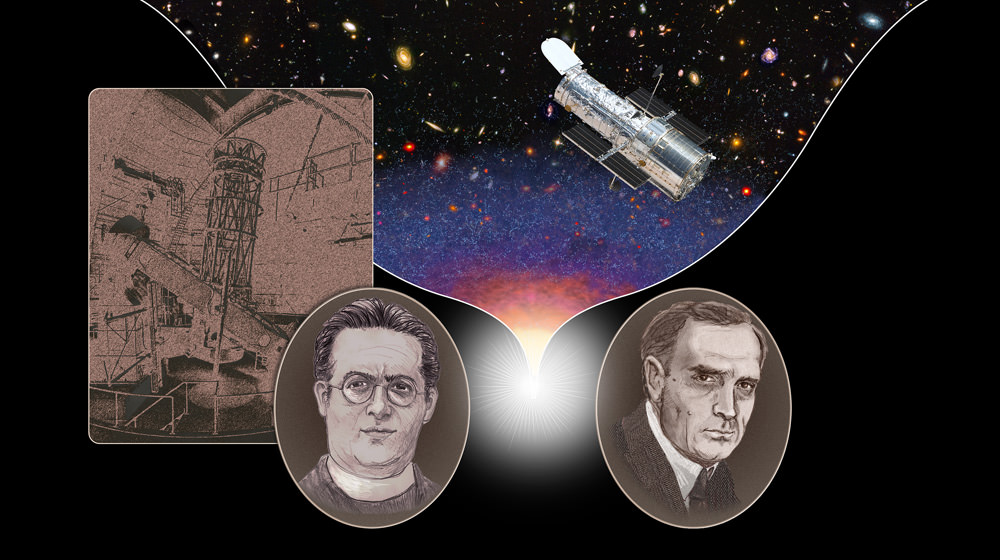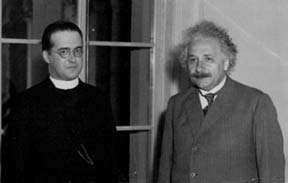We have been spoiled over recent years with first the Hubble Space Telescope (HST) and then the James Webb Space Telescope (JWST.) Both have opened our eyes on the Universe and made amazing discoveries. One subject that has received attention from both is the derivation of the Hubble Constant – a constant relating the velocity of remote galaxies and their distances. A recent paper announces that JWST has just validated the results of previous studies by the Hubble Space Telescope to accurately measure its value.
Continue reading “James Webb Confirms Hubble’s Calculation of Hubble’s Constant”The Expanding Universe – Credit To Hubble Or Lemaitre?

[/caption]
Perhaps one of the greatest astronomical discoveries of the 20th century may have gone down in the history books as credited to the wrong person. Now known as the Hubble Constant, the theory of an expanding Universe was first speculated by Belgian priest and cosmologist, Father Georges Lemaitre. How did this oversight occur? It may very well be the hand of the man himself who was unpretentious enough to pass on his findings.
According to the the November 10th issue of the journal Nature, astrophysicist Mario Livio of the Space Telescope Science Institute is calling for closure about a conspiracy theory of who should be properly credited for the discovery of the expansion theory. For almost a hundred years we’ve been led to believe American astronomer Edwin P. Hubble was the man who explained the universal expansion in 1929 – although he never won a Nobel prize for his work. His findings were based on the achievements of Vesto Slipher, who – through the use of redshift – calculated recessional velocities and paired them with distances to the same galaxies as Hubble’s work. This led Hubble to demonstrate that the further away a galaxy was, the faster it would recede… the Hubble Constant.
However, two years before Hubble published his work, a quiet man called Georges Lemaitre published the same conclusions based on Slipher’s same redshift data and Hubble’s calculated distances.
How did this happen and why didn’t Father Lemaitre get credit? According to news release, it may have been because the original paper was published in French, in a rather obscure Belgian science journal called the Annales de la Societe Scientifique de Bruxelles (Annals of the Brussels Scientific Society). Chances are, we never would have known except for a later translation which was published in the Monthly Notices of the Royal Astronomical Society in 1931… a paper which just “left out” Lemaitre’s 1927 calculations! Of course, there were people who knew these passages had been omitted since 1984 and the ensuing debate accused not only the editors of the Monthly Notices, but Hubble as well.
However, before any accusations can be made, let it be noted that astrophysicist Mario Livio combed through an exhaustive archive of hundreds of letters to the Royal Astronomical Society and the RAS meeting minutes – as well as Father Lemaitre’s Archive. What he found was the good Father had simply omitted the passages himself when he translated the papers to English. In one of two “smoking-gun letters” uncovered by Livio, Lemaitre wrote to the editors: “I did not find advisable to reprint the provisional discussion of radial velocities which is clearly of no actual interest, and also the geometrical note, which could be replaced by a small bibliography of ancient and new papers on the subject.”
What is left for us to ponder is “why” Georges Lemaitre didn’t want to take credit for this discovery. Can there really be an altruistic scientist? One who puts the simple act of discovery above himself?
Livio concludes, “Lemaitre’s letter also provides an interesting insight into the scientific psychology of some of the scientists of the 1920s. Lemaitre was not at all obsessed with establishing priority for his original discovery. Given that Hubble’s results had already been published in 1929, he saw no point in repeating his more tentative earlier findings again in 1931.”
Excuse me, folks… After having read the original news release, I think we should rename the Hubble Telescope to read the “Humble Telescope”.
Original Story Source: Hubblesite News Release.


